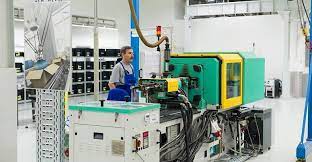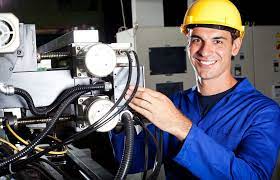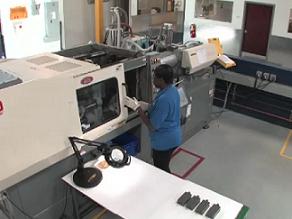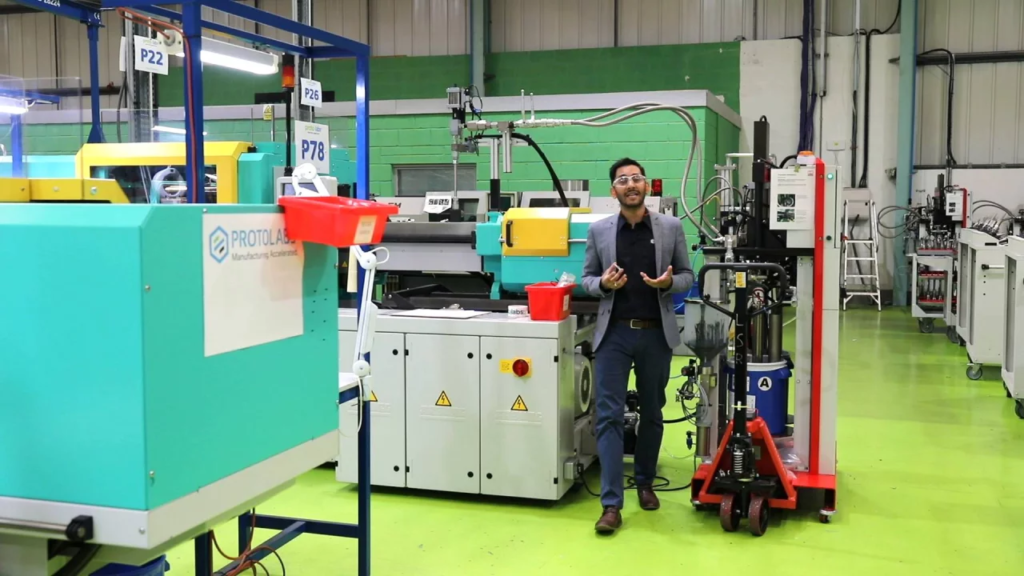Free Plastic Moulding Operator Course (6Months)
Plastic Moulding Operator/Technician:
Brief Job Description
This role primarily involves managing the specifications of the plastic and its granules, setting up and operating the moulding machinery and forming & finishing the output.
Personal Attributes
Reading, writing and communication skills, ability to plan and prioritize, quality consciousness, safety orientation, Physique to sustain strenuous conditions, Dexterity, Ability to use fingers, hands and feet with ease to complete the assigned task (Dexterity), high precision and sensitivity to problem solving and sensitivity towards safety for self and equipment.

Maintain a safe and healthy working environment:
Elements and Performance Criteria
Identify and report the risks identified
To be competent, the user/individual on the job must be able to:

PC1.. Identify activities which can cause potential injury through sharp objects, burns, fall, electricity, gas leakages, radiation, poisonous fumes, chemicals ,loud noise
PC2. Inform the concerned authorities about the potential risks identified in the processes, workplace area/ layout, materials used etc
PC3. Inform the concerned authorities about machine breakdowns, damages which can potentially harm man/ machine during operations
PC4. Create awareness amongst other by sharing information on the identified risks
Create and sustain a Safe, clean and environment friendly work place
To be competent, the user/individual on the job must be able to:
PC5.. Follow the instructions given on the equipment manual describing the operating process of the equipments
PC6.. Follow the Safety, Health and Environment related practices developed by the organization
PC7. Operate the machine using the recommended Personal Protective Equipments (PPE)
PC8. . Maintain a clean and safe working environment near the work place and ensure there is no spillage of chemicals, production waste, oil, solvents etc
PC9. Maintain high standards of personal hygiene at the work place
PC10. Ensure that the waste disposal is done in the designated area and manner as per organization SOP.
PC11. Inform appropriately the medical officer/ HR in case of self or an employees illness of contagious nature so that preventive actions can be planned for others
Knowledge and Understanding (KU)
The individual on the job needs to know and understand:
KU1. relevant standards, procedures and policies related to Health, Safety and Environment followed in the company
KU2. basic knowledge of Safety procedures( fire fighting, first aid) within the organization
KU3. knowledge of various types of PPEs and their usage
KU4. basic knowledge of risks/hazards associated with each occupation in the organization
KU5. how to safely operate various tools and machines and risksassociated with the tools/ equipment
KU6. knowledge of personal hygiene and how an individual an contribute towards creating a highly safe and clean working environment
Generic Skills (GS)
User/individual on the job needs to know how to:
GS1. write basic level notes and observations
GS2. read safety instructions put up across the plant premises
GS3. read safety precautions mentioned in equipment manuals and panels to understand the potential risks associated
GS4. effectively communicate information to team members
GS5. informemployees in the plant and concerned functions about events, incidents & potential risks observed related to Safety, Health and Environment.
GS6. question operator/ supervisor in order to understand the safety related issues
GS7. attentively listen with full attention and comprehend the information given by the speaker during safety drills and training programs
GS8. use common sense and make judgments during day to day basis
GS9. use reasoning skills to identify and resolve basic problems
GS10. use common sense and make judgments during day to day basis
GS11. use reasoning skills to identify and resolve basic problems

Maintain 5S at the work premises:
Elements and Performance Criteria
Ensure sorting
To be competent, the user/individual on the job must be able to:

PC1.. follow the sorting process and check that the tools, fixtures & jigs that are lying on workstations are the ones in use and unnecessary items are not cluttering the workbenches or work surfaces.
PC2.. ensure segregation of waste in hazardous/ non hazardous waste as per the sorting work instructions
PC3.. follow the technique of waste disposal and waste storage in the proper bins as per sop
PC4.. segregate the items which are labelled as red tag items for the process area and keep them in the correct places
PC5. sort the tools/ equipment/ fasteners/ spare parts as per specifications/ utility into proper trays, cabinets, lockers as mentioned in the 5s guidelines/ work instructions
PC6. . ensure that areas of material storage areas are not overflowing
PC7. properly stack the various types of boxes and containers as per the size/ utility to avoid any fall of items/ breakage and also enable easy sorting when required
PC8. return the extra material and tools to the designated sections and make sure that no additional material/ tool is lying near the work area
PC9. follow the floor markings/ area markings used for demarcating the various sections in the plant as per the prescribed instructions and standards
PC10. follow the proper labeling mechanism of instruments/ boxes/ containers and maintaining reference files/ documents with the codes and the lists
Ensure proper documentation and storage ( organizing , streamlining)
To be competent, the user/individual on the job must be able to:
PC11. check that the items in the respective areas have been identified as broken or damaged
PC12. follow the given instructions and check for labelling of fluids, oils. lubricants, solvents, chemicals etc. and proper storage of the same to avoid spillage, leakage, fire etc
PC13. make sure that all material and tools are stored in the designated places and in the manner indicated in the 5s instructions
Ensure cleaning of self and the work place
To be competent, the user/individual on the job must be able to:
PC14. check whether safety glasses are clean and in good condition
PC15. keep all outside surfaces of recycling containers are clean
PC16.. ensure that the area has floors swept, machinery clean and generally clean. in case of cleaning, ensure that proper displays are maintained on the floor which indicate potential safety hazards
PC17.. check whether all hoses, cabling & wires are clean, in goodcondition and clamped to avoid any mishap or mix up
PC18.. ensure workbenches and work surfaces are clean and in good condition
PC19. follow the cleaning schedule for the lighting system to ensure proper illumination
PC20. store the cleaning material and equipment in the correct location and in good condition
PC21. ensure self-cleanliness – clean uniform, clean shoes, clean gloves, clean helmets, personal hygiene
Ensure sustenance
To be competent, the user/individual on the job must be able to:
PC22. follow the daily cleaning standards and schedules to create a clean working environment
PC23. attend all training programs for employees on 5 s
PC24. support the team during the audit of 5 s
PC25. participate actively in employee work groups on 5s and encourage team members for active participation
PC26. follow the guidelines for what to do and what not to do to build sustainability in 5s as mentioned in the 5s check lists/ work instructions
Knowledge and Understanding (KU)
The individual on the job needs to know and understand:
KU1. relevant standards, procedures and policies related to 5S followed in the company
KU2. have basic knowledge of 5S procedures
KU3. know various types 5s practices followed in various areas
KU4. understand the 5S checklists provided in the department/ team
KU5. have skills to identify useful & non useful items
KU6. have knowledge of labels , signs & colours used as indicators
KU7. knowledge on how to sort and store various types of tools, equipment, material etc.
KU8. know , how to identify various types of waste products
KU9. understand the impact of waste/ dirt/ dust/unwanted substances on the process/ environment/ machinery/ human body
KU10. have knowledge of best ways of cleaning & waste disposal
KU11. understand the importance of standardization in processes
KU12. understand the importance of sustainability in 5S
KU13. have knowledge of TQM process
KU14. have knowledge of various materials and storage norms
KU15. understand visual controls, symbols, graphs etc.

Generic Skills (GS)
User/individual on the job needs to know how to:
GS1. write basic level notes and observations
GS2. note down observations (if any) related to the process
GS3. read 5S instructions put up across the plant premises
GS4. effectively communicate information to team members inform employees in the plant and concerned functions about 5S
GS5. question the process head in order to understand the 5S related issues
GS6. attentively listen with full attention and comprehend the information given by the speaker during 5S training programs
GS7. use common sense and make judgments during day to day basis
GS8. use reasoning skills to identify and resolve basic problems using 5S
GS9. persuade co team members to follow 5 S
GS10. ensure that the co team members understand the importance of using 5 S tool
GS11. use innovative skills to perform and manage 5 S activities at the work desk and the shop floor
GS12. exhibit inquisitive behaviour to seek feedback and question on the existing set patterns of work
GS13. do what is right, not what is a popular practices
GS14. follow shop floor rules& regulations and avoid deviations; make 5S an integral way of life
GS15. ensure self-cleanliness on a daily basis
GS16. demonstrate the will to keep the work area in a clean and orderly manner
Understand plastic moulding job requirements and related processes:

Elements and Performance Criteria
Understand the work order and the process requirements
To be competent, the user/individual on the job must be able to:
PC1.. understand the work order ( work output) required from the process and discuss the same with the supervisor
PC2.. refer all sketches/ work orders/ process related documents to understand dimensions and properties of the required work output
PC3.. understand the process requirements in terms of temperature of the heater, hydraulic pressure/ air pressure/ vacuum pressure, rotating speed of the screw pressure, regulating current, injection time, refilling time etc. as mentioned in the work instruction/ sop/ control diagrams
PC4.. clearly understanding the does and donts of the manufacturing process as defined in SOPs/ work instructions or defined by supervisors
Arrange for the material to be moulded and apparatus required for the same
To be competent, the user/individual on the job must be able to:
PC5.. understand the moulding procedure and process to be adopted for completing the work order from the supervisor by referring the work instruction document/ SOP manual
PC6.. set the various moulding parameters like temperature of the heaters, hydraulic pressure/ air pressure/ vacuum pressure, rotating speed of the screw, screw pressure, regulating current, flow of coolant/ water etc. before starting the process. moulding parameters are mentioned in the work instructions/ SOP manual
PC7.. understand the raw material like plastics granules, bonding additives etc. required for executing the activity
PC8.. ensure that the required material is procured from the store before starting the process
PC9.. understand the type of die required for executing the required moulding operation and ensure that the same is available for moulding operations
PC10.. understand the number of heaters required for the moulding operations, heater temperature and current required for the heating operations as mentioned in the work instructions/ sop manual
Clean the apparatus and the components before executing the process
To be competent, the user/individual on the job must be able to:
PC11.. ensure cleaning of dies and machine runners by spraying or brushing surfaces with parting agents to ensure smoothness and prevent clogging of plastic in the machine parts/ dies
PC12.. ensure cleaning of the other moulding machine tools, auxiliaries(if any) before the initiation of the moulding and trimming process
PC13.. ensure cleaning of the area around the apparatus for any oil, grease, combustible substances etc. so as to prevent any accident
Check materials and apparatus for Operations
To be competent, the user/individual on the job must be able to:
PC14.. use weighing machines to measure the quantity of granules and ensure that the correct quantity of granules are put in the hopper
PC15.. check the parameters temperature, pressure, current, screw speed etc. in line with the work instructions/ sops
PC16.. setup the moulding apparatus as per the selected moulding process and the moulding standards used in the automobile industry
PC17.. adjust the temperature and other parameters of the moulding apparatus as per the values given in work instructions/ sops
PC18.. ensure availability of the coolant and working of valves to circulate the coolant to cool and solidify plastic
Escalations of queries on the given job
To be competent, the user/individual on the job must be able to:
PC19.. refer the queries to supervisor if they cannot be resolved by the operator
PC20.. confirm self – understanding to the supervisor once the query is resolved so that all doubts & queries can be resolved before the actual process execution

Knowledge and Understanding (KU)
The individual on the job needs to know and understand:
KU1. relevant standards and procedures followed in the company
KU2. different types of products manufactured by the company
KU3. functional processes like Procurement, Store management, inventory management, quality management and key contact points for query resolution
KU4. different parameters pertinent to moulding process like heater temperature, hydraulic pressure/ air pressure/ vacuum pressure, rotating speed of the screw, operating current and voltage, injection time, refilling timeetc. and the impact of these parameters on the process output
KU5. various types of plastics like thermoplastics/ thermosetting plastics and the additives to be used
KU6. different types of tools and machinery to mould the plastic and trim the output
KU7. various types of coolants and their properties
KU8. geometry and dimension measurement of the product output
KU9. sketches and engineering drawings
KU10. how to visualize final product output and hence decide on the key steps to be followed
KU11. different types of cleaning techniques, moulding processes and associated equipments
KU12. measuring instruments like verniercallipers, micrometres
KU13. hazards and safety aspects involved in moulding activities and usage of relevant PPEs
Generic Skills (GS)
User/individual on the job needs to know how to:
GS1. document information from the sketches and engineering drawings
GS2. prepare draft drawings for the final output product
GS3. write information documents to internal departments/ internal teams or enter the information in online ERP systems under guidance of the supervisor
GS4. read and interpret engineering drawing and sketches
GS5. read equipment manuals and process documents to understand the equipment and processes better
GS6. read instructions especially safety instructions especially symbols while using the equipment in the plant area
GS7. read internal drawings send by internal customers ( other functions within the organization)
GS8. discuss task lists, schedules, and work-loads with co-workers
GS9. question internal customers/ Moulding shop supervisor appropriately in order to understand the nature of the problem and make a diagnosis
GS10. avoid using jargon, slang or acronyms when communicating with a customer, unless it is required
GS11. plan and organize the work order and jobs received from the internal customers
GS12. plan and organize the design documents received from internal customers
GS13. organize all process/ equipment manuals so that sorting out information is fast
GS14. use common sense and make judgments during day to day basis
GS15. use reasoning skills to identify and resolve basic problems
GS16. use intuition to detect any potential problems which could arise during operations
GS17. follow instructions and work on areas of improvement identified
GS18. complete the assigned tasks with minimum supervision
GS19. complete the job defined by the supervisor within the timelines and quality norms
GS20. detect problems in day to day tasks
GS21. support supervisor in using specific problem solving techniques and detailing out the problems
GS22. discuss possible solution with the supervisor for problem solving
GS23. make decisions in emergency conditions in case the supervisor is not available( as per the authority matrix defined by the organization)
Perform the moulding related operations and monitor process parameters:
Elements and Performance Criteria
Check the operations of the equipment used in the moulding process
To be competent, the user/individual on the job must be able to:
PC1.. check for operation of molding apparatus like hopper, pouring nozzles, heaters, reciprocating screws, plungers etc. as per the checklist provided
PC2.. fix the desired die to the extrusion apparatus in order to achieve the desired shape as per the work instructions/ sops
PC3.. make modifications in the molding parameters ( by selecting the right program from the machine control system) if required and ensure alignment with the prescribed standards
Feed the plastic granules in the hopper and conduct a test process
To be competent, the user/individual on the job must be able to:
PC4.. perform preheating of plastic granules to improve their tensile strength
PC5.. ensure that the plastic granules are mixed with additives (if any) before being fed into the hopper
PC6.. turn valves of machines to regulate speed and quantity of the plastic coming out of the hopper
PC7.. ensure pouring in line with the defined standards and specifications
PC8.. record the feeding observations like parting leak, interrupted pouring or any abnormality
PC9.. conduct a test process and produce a sample output as per the sketches/ engineering drawing shared with the operator
PC10.. check the first piece for geometry, material & dimensional parameters as per the control plan before starting the production
PC11.. ensure that the dimensions of the output product are measured as per the process given in the work instructions/ SOP
PC12.. in case the test product matches the dimensions and quality of the final output, start the production process
Conduct the actual moulding process
To be competent, the user/individual on the job must be able to:
PC13.. feed the required operation code in the apparatus for heaters to melt the plastic granules at the predefined temperature
PC14.. adjust the screw speed and the screw pressure to force the molten plastic into the die to create the desired output shape
PC15.. turn valves of machines to regulate speed and quantity of the plastic coming out of the hopper
PC16.. ensure feeding in line with the defined standards and specifications
PC17.. record the feeding observations like parting leak, interrupted pouring or any abnormality
PC18.. ensure the proper functioning of screen pack for uniform melting of plastic and removal of the contaminants (if any)
PC19.. monitor the molding process (parameters like temperature, pressure etc.) by observing and analyzing the readings on various panels/ meters to prevent machine breakdown and deviations of the output from desired specifications
PC20.. observe and analyze any irregularity in the process and take preventive steps
PC21.. remove the output from the machine once the cycle is complete using proper clamps and other handling tools to carefully pick the product from the machine area
PC22.. in case the output has to be separately cooled, ensure that the helper cools it using the cooling process as mentioned in the work instructions/ sops
PC23.. clean the plastic molding to remove runners/ gates or extra materials through de-gating and de -flashing processes
PC24.. ensure stamping of the molding with the identifying information (wherever required) and send the same for further processing
PC25.. instruct the helper to cut the output molding as per the desired geometric specifications ( removal of runners)
Perform the visual inspection of the output to further finish the moulding
To be competent, the user/individual on the job must be able to:
PC26.. measure the final plastic product and compare the dimensions as prescribed in the work order/ engineering drawing
PC27.. in case the parts are not as per the given measurements, send the same for further processing in terms of cutting, finishing etc.
Knowledge and Understanding (KU)
The individual on the job needs to know and understand:
KU1. relevant standards and procedures followed in the company
KU2. different types of products manufactured by the company
KU3. functional processes like Procurement, Store management, inventory management, quality management and key contact points for query resolution
KU4. quality norms prescribed by the organization for moulding jobs
KU5. how to read panels, meters, indicators etc. to monitor the process
KU6. different types of moulding processes, associated equipment like dies, screw/ reciprocating screw/ plunger, heaters etc. and their working
KU7. number of heaters required to generate the given temperature/ current requirements
KU8. different parameters pertinent to moulding process like heater temperature, hydraulic pressure/ air pressure/ vacuum pressure, rotating speed of the screw, operating current and voltage, injection time, refilling time etc. and the impact of these parameters on the process
KU9. various types of plastics like thermoplastics/ thermosetting plastics and their properties
KU10. various types of coolants. and their properties
KU11. moulding defects and how they are generated, how they can be prevented, different consumables used in the melt shop
KU12. extruder operation, melting process, and safety process of handling hot moltenplasticand control mechanisms for the extrusion machine
KU13. measuring instruments like vernier callipers, micrometers and other tools
KU14. impact of operators work on moulding quality at in house and at customers, how to improve customers satisfaction
KU15. geometry and dimension measurement
KU16. sketches and engineering drawings
KU17. how to visualize final product output and hence decide on the key steps to be followed
KU18. safety precautions to be taken for all types of moulding activities
Generic Skills (GS)
User/individual on the job needs to know how to:
GS1. document information from the sketches and engineering drawings
GS2. write log book in terms of output quantity, set up parameters, machine setting parameters and loss details etc.
GS3. prepare draft drawings for the final output product
GS4. write drawings to internal customers on the requirement of moulding plastic, moulding apparatus etc.
GS5. note measurements, equipment panel readings for various process parameters in the required reporting formats
GS6. read and interpret engineering drawing and sketches
GS7. read equipment manuals and process documents to understand the equipment and processes better
GS8. read instructions especially safety instructions especially symbols while using the equipment in the plant area
GS9. read internal drawings send by internal customers ( other functions within the organization)
GS10. discuss task lists, schedules, and work-loads with co-workers
GS11. question internal customers/ Moulding shop supervisor appropriately in order to understand the nature of the problem and make a diagnosis
GS12. plan and organize the work order and jobs received from the internal customers
GS13. plan and organize the design documents received from internal customers
GS14. organize all process/ equipment manuals so that sorting out information is fast
GS15. organize apparatus etc. in an orderly manner at proper designated areas
GS16. visualize the final job product after understanding the given drawing/ sketches
GS17. carefully measure the moulding so in terms of the geometrical dimensions so that the final output is as pre the given drawing
GS18. finalize the optimum levels of physical parameters so that the job output meets the prescribed job standards
GS19. detect problems in day to day tasks
GS20. support supervisor in using specific problem solving techniques and detailing out the problems
GS21. discuss possible solution with the supervisor for problem solving
GS22. make decisions in emergency conditions in case the supervisor is not available( as per the authority matrix defined by the organization)
GS23. follow instructions and work on areas of improvement identified
GS24. complete the assigned tasks with minimum supervision
GS25. complete the job defined by the supervisor within timelines and quality norms
Assessment Guidelines:
- Criteria for assessment for each Qualification Pack will be created by the Sector Skill Council. Each Element/ Performance Criteria (PC) will be assigned marks proportional to its importance in NOS. SSC will also lay down proportion of marks for Theory and Skills Practical for each Element/ PC.
- The assessment for the theory part will be based on knowledge bank of questions created by the SSC.
- Assessment will be conducted for all compulsory NOS, and where applicable, on the selected elective/option NOS/set of NOS.
- Individual assessment agencies will create unique question papers for theory part for each candidate at each examination/training center (as per assessment criteria below).
- Individual assessment agencies will create unique evaluations for skill practical for every student at each examination/ training center based on these criteria.
- To pass the Qualification Pack assessment, every trainee should score the Recommended Pass % aggregate for the QP.
- In case of unsuccessful completion, the trainee may seek reassessment on the Qualification Pack.








